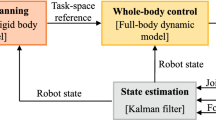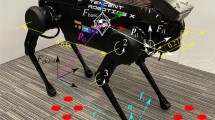Abstract
Fast trajectory planning and control frameworks improve locomotion robustness against disturbances and uncertainties. In this paper, dynamic motions are optimized under the constraint of a decoupled spring-loaded inverted pendulum model. Subsequently, a hierarchical Quadratic Programming whole-body controller is employed to execute the planned trajectories while ensuring compliance with all physical feasibility constraints. Both the motion planner and the whole-body controller operate within the same high-frequency control loop. Furthermore, the unified whole-body controller governs all gait phases, including flight phases. The proposed algorithms are evaluated through simulation and real experiments, showcasing dynamic gaits such as hopping, twist jumping, and trotting in challenging environments. The algorithms demonstrate resilience against external disturbances and environmental uncertainties.
















Similar content being viewed by others
Data availibility
Data sharing not applicable to this article as no datasets were generated or analysed during the current study.
References
Yang, C., Yuan, K., Zhu, Q., Yu, W., Li, Z.: Multi-expert learning of adaptive legged locomotion. Sci. Robot. 5, eabb2174 (2020)
Lee, J., Hwangbo, J., Wellhausen, L., Koltun, V., Hutter, M.: Learning quadrupedal locomotion over challenging terrain. Sci. Robot. 5, eabc5986 (2020)
Hwangbo, J., et al.: Learning agile and dynamic motor skills for legged robots. Sci. Robot. 4, eaau5872 (2019)
Winkler, A.W., Bellicoso, C.D., Hutter, M., Buchli, J.: Gait and trajectory optimization for legged systems through phase-based end-effector parameterization. IEEE Robot. Autom. Lett. 3, 1560–1567 (2018)
Sleiman, J.-P., Farshidian, F., Minniti, M.V., Hutter, M.: A unified MPC framework for whole-body dynamic locomotion and manipulation. IEEE Robot. Autom. Lett. 6, 4688–4695 (2021)
Mastalli, C., et al.: Crocoddyl: an efficient and versatile framework for multi-contact optimal control, pp. 2536–2542. IEEE (2020)
Cebe, O., et al.: Online dynamic trajectory optimization and control for a quadruped robot, pp. 12773–12779 (2021)
Kim, D., Di Carlo, J., Katz, B., Bledt, G., Kim, S.: Highly dynamic quadruped locomotion via whole-body impulse control and model predictive control (2019). arXiv preprint arXiv:1909.06586
Kajita, S., et al.: Biped walking pattern generation by using preview control of zero-moment point, vol. 2, pp. 1620–1626. IEEE (2003)
Mordatch, I., de Lasa, M., Hertzmann, A.: Robust physics-based locomotion using low-dimensional planning. ACM Trans. Graph 29(4) (2010). https://doi.org/10.1145/1778765.1778808
Apgar, T., Clary, P., Green, K., Fern, A., Hurst, J.W.: Fast online trajectory optimization for the bipedal robot Cassie. In: Robotics: Science and Systems, vol. 101, p. 14. Pittsburgh, Pennsylvania, USA (2018)
Xin, G., et al.: Robust footstep planning and LQR control for dynamic quadrupedal locomotion. IEEE Robot. Autom. Lett. 6, 4488–4495 (2021)
Bloesch, M., et al.: State estimation for legged robots-consistent fusion of leg kinematics and IMU. Robotics 17, 17–24 (2013)
Pratt, J., Chew, C.-M., Torres, A., Dilworth, P., Pratt, G.: Virtual model control: an intuitive approach for bipedal locomotion. Int. J. Robot. Res. 20, 129–143 (2001)
Boaventura, T., et al.: Dynamic torque control of a hydraulic quadruped robot, pp. 1889–1894. IEEE (2012)
Gehring, C., et al.: Control of dynamic gaits for a quadrupedal robot, pp. 3287–3292. IEEE (2013)
Feng, S., Whitman, E., Xinjilefu, X., Atkeson, C.G.: Optimization based full body control for the atlas robot. In: IEEE-RAS International Conference on Humanoid Robots, 2015-Feb, pp. 120–127 (2015)
Di Carlo, J., Wensing, P.M., Katz, B., Bledt, G., Kim, S.: Dynamic locomotion in the MIT cheetah 3 through convex model-predictive control, pp. 1–9. IEEE (2018)
Xin, S., Orsolino, R., Tsagarakis, N.: Online relative footstep optimization for legged robots dynamic walking using discrete-time model predictive control. In: 2019 IEEE/RSJ International Conference on Intelligent Robots and Systems (IROS), pp. 513–520. IEEE (2019)
De Lasa, M., Mordatch, I., Hertzmann, A.: Feature-based locomotion controllers, vol. 29, 131. ACM (2010)
Del Prete, A., Nori, F., Metta, G., Natale, L.: Prioritized motion-force control of constrained fully-actuated robots “task space inverse dynamics’’. Robot. Auton. Syst. 63, 150–157 (2015)
Herzog, A., et al.: Momentum control with hierarchical inverse dynamics on a torque-controlled humanoid. Auton. Robot. 40, 473–491 (2016)
Dario Bellicoso, C., Gehring, C., Hwangbo, J., Fankhauser, P., Hutter, M.: Perception-less terrain adaptation through whole body control and hierarchical optimization. In: IEEE-RAS International Conference on Humanoid Robots, pp. 558–564 (2016)
Kajita, S., Matsumoto, O., Saigo, M.: Real-time 3d walking pattern generation for a biped robot with telescopic legs, vol. 3, pp. 2299–2306. IEEE (2001)
Kajita, S., Hirukawa, H., Harada, K., Yokoi, K.: Introduction to humanoid robotics, vol. 101. Springer (2014)
Dasgupta, A., Nakamura, Y.: Making feasible walking motion of humanoid robots from human motion capture data. In: Proceedings 1999 IEEE international conference on robotics and automation (Cat. No. 99CH36288C), vol. 2, pp. 1044–1049. IEEE (1999)
Wensing, P.M., Orin, D.E.: Improved computation of the humanoid centroidal dynamics and application for whole-body control. Int. J. Humanoid Rob. 13, 1550039 (2016)
Orin, D.E., Goswami, A., Lee, S.-H.: Centroidal dynamics of a humanoid robot. Auton. Robot. 35, 161–176 (2013)
Mistry, M., Buchli, J., Schaal, S.: Inverse dynamics control of floating base systems using orthogonal decomposition. In: Proceedings—IEEE International Conference on Robotics and Automation, pp. 3406–3412 (2010)
Wächter, A., Biegler, L.T.: On the implementation of an interior-point filter line-search algorithm for large-scale nonlinear programming. Math. Program. 106, 25–57 (2006)
Wang, K., et al.: A unified model with inertia shaping for highly dynamic jumps of legged robots (2021). arXiv preprint arXiv:2109.04581
Acknowledgements
The authors would like to thank Ke Wang from Imperial College London for the trajectory generation of the 90\(^\circ \) twist jumping, and Dr. Wolfgang Merkt from the University of Oxford for the experimental tests of the proposed algorithms on the ANYmal Boxy robot at Oxford.
Funding
This work was supported in part by Grants EPSRC UK RAI Hubs NCNR (EP/R02572X/1), ORCA (EP/R026173/1) and EU Horizon 2020 THING (ICT-27-2017 780883), the Liaoning and Guangdong Basic and Applied Basic Research Foundation [2023JH2/101600033] [2022A1515140156], the Fundamental Research Funds for the Central Universities [82232025], the State Key Laboratory of Robotics and Systems funding [SKLRS-2023-KF-16]. Dalian Science and Technology Innovation Funding (2023JJ12GX017).
Author information
Authors and Affiliations
Contributions
All authors contributed to the study conception and design. Material preparation, data collection and analysis were performed by GX. The first draft of the manuscript was written by GX and all authors commented on previous versions of the manuscript. All authors read and approved the final manuscript.
Corresponding author
Ethics declarations
Conflict of interests
The authors have no relevant financial or non-financial interests to disclose.
Additional information
Publisher's Note
Springer Nature remains neutral with regard to jurisdictional claims in published maps and institutional affiliations.
Appendix
Appendix
1.1 Dimension reduction
Equation (20) can be directly split into two equations
where \(\textbf{M}_f\in \mathbb {R}^{6\times (6+n)}\), \(\textbf{h}_f \in \mathbb {R}^6\) and \(\textbf{J}_{c,f} \in \mathbb {R}^{3\,m \times 6}\) denote the floating base components of the dynamic matrices while \(\textbf{M}_a\in \mathbb {R}^{n\times (6+n)}\), \(\textbf{h}_a \in \mathbb {R}^n\) and \(\textbf{J}_{c,a} \in \mathbb {R}^{3\,m \times n}\) represent the actuated components. Apparently \(\varvec{\tau }\) is determined by Eq. (39) as follows
Therefore, the decision variable can be reduced to \(\textbf{y}=\begin{bmatrix}\ddot{\textbf{q}}^\top&\varvec{\lambda }^\top \end{bmatrix}^\top \), and the physical feasibility constraint Eq. (28) becomes
The dimensions of the cost functions also need to be modified using the reduced decision variable.
Rights and permissions
Springer Nature or its licensor (e.g. a society or other partner) holds exclusive rights to this article under a publishing agreement with the author(s) or other rightsholder(s); author self-archiving of the accepted manuscript version of this article is solely governed by the terms of such publishing agreement and applicable law.
About this article
Cite this article
Xin, G., Mistry, M. Optimization-based dynamic motion planning and control for quadruped robots. Nonlinear Dyn 112, 7043–7056 (2024). https://doi.org/10.1007/s11071-024-09445-7
Received:
Accepted:
Published:
Issue Date:
DOI: https://doi.org/10.1007/s11071-024-09445-7




